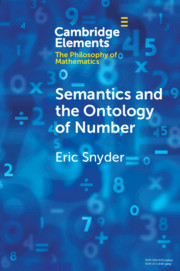Element contents
Semantics and the Ontology of Number
Published online by Cambridge University Press: 26 April 2021
Summary
Keywords
- Type
- Element
- Information
- Online ISBN: 9781108602259Publisher: Cambridge University PressPrint publication: 20 May 2021
Bibliography
- 17
- Cited by



